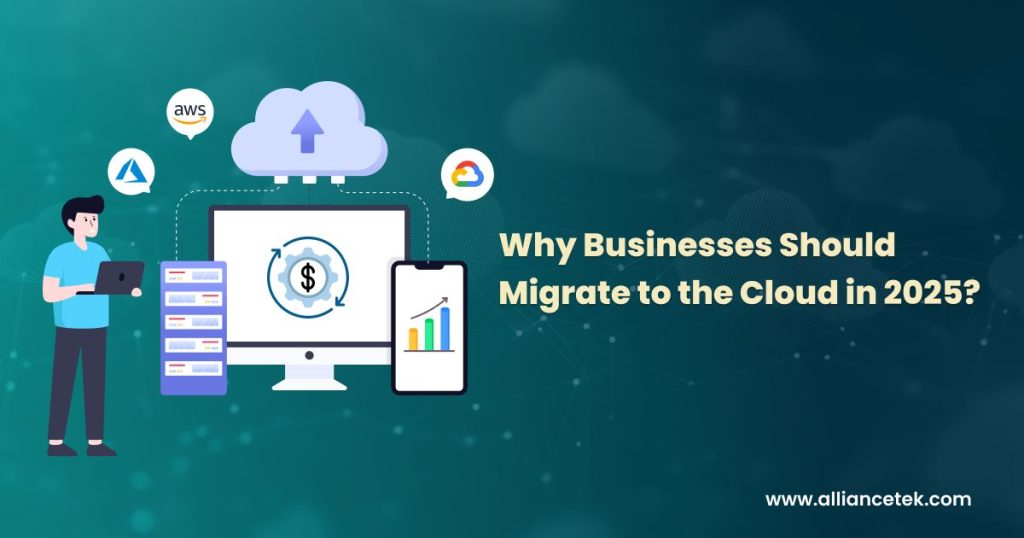Why Businesses Should Migrate to the Cloud in 2025?

Cloud computing has become more of a business reality than a buzzword. In the last ten years, both large and small organizations have embraced cloud computing services as a way of reducing costs, enhancing scalability, and remaining competitive.
However, 2025 is an especially critical date. The current year is a great opportunity for businesses that have been slow to finally take the plunge into the cloud due to developments in artificial intelligence (AI), global connectivity, and regulatory frameworks. Many technology firms that previously focused on traditional web development now leverage cloud computing solutions to deliver scalable digital transformations.
We discuss below the major reasons why every business should consider moving to the cloud computing architecture by 2025 and how to do it in a practical way to make the transition seamless and strategic. Companies that already excel at cloud computing applications find it easier to adapt their services to cloud-native environments.
The Cloud Is Now a Proven, Trusted Platform
The major players like Amazon web services (AWS), Microsoft Azure, and Google Cloud have spent billions on security infrastructure, distributed data centres, and certifications of compliance. Firms that aim to hire cloud engineers often prefer candidates who understand these cloud environments.
- Security improvements: End-to-end encryption, zero-trust architecture, and threat detection based on AI have become the norm. Most cloud services are currently more secure than on-premise systems. In parallel, teams focused on cloud computing software can automate security checks within these robust infrastructures.
- Reliability: Service-level agreements (SLAs) are often guaranteed to be 99.99% or higher, which means that the business is not interrupted during the peak period or during unexpected disruption. The ability to combine legacy systems with cloud services also makes cloud computing architecture a valuable step in modernization.
To businesses that are evaluating the dangers of remaining on the old servers or transitioning to the cloud, the scales have shifted in favour of the latter. Partnering with an experienced cloud consultant or deciding to hire cloud experts can further reduce migration risks.
AI and Machine Learning Are Cloud-Native
A seasoned cloud computing services provider can help integrate AI-driven features into custom business applications.
Turnkey AI and machine learning (ML) services are now available through cloud computing platforms and allow businesses to:
- Implement predictive analytics without the need to employ a team of data scientists.
- Combine natural language processing, computer vision, and generative AI into applications.
- Scales experimentation is fast when there is an increase in the volume of data.
Teams delivering cloud computing applications especially benefit from such AI-based analytics. The thing is that in 2025, it is often necessary to be competitive by using AI. Small startups and large enterprises can do that using the cloud. Some even hire cloud developers to build intelligent dashboards and services.
Cost Efficiency and Predictable Spending
This model will be particularly useful in an uncertain economic environment in 2025, whereby the agility factor is more crucial than ever before. Forward-looking agencies also provide Open Source customization to lower licensing costs.
The major financial benefits are:
- Operational vs. capital expenses: CapEx to OpEx conversion opens up capital to innovation and growth.
- Elastic scaling: Scale resources automatically up, or down in response to real-time demand, without incurring the cost of idle infrastructure.
- Open pricing: Customized billing dashboards enable IT executives to track use and estimate costs.
Many organizations now hire cloud consultants or hire cloud migration specialists to optimize costs and design efficient architectures for cloud computing services.
Global Workforce and Remote Collaboration
Many businesses, therefore, hire cloud experts who can work remotely and integrate seamlessly with distributed teams.
Cloud migration also brings about the following:
- Employees are able to access data and applications safely from any place or even from any device.
- Teams work together simultaneously with documents, designs, and code.
- The identity, access, and compliance can be managed centrally on a dashboard by IT departments. For some, it even makes sense to hire cloud engineers to manage complex global deployments.
By 2025, firms that continue to be bound to on-premise servers will be exposed to wasted time and lost talent to more adaptable firms. Others will expand further to hire cloud developers for 24/7 operations.
Sustainability and ESG Goals
Environmental, social, and governance (ESG) commitments are no longer optional. Customers, investors, and regulators increasingly expect companies to track and reduce their carbon footprint.
Cloud providers operate massive, energy-efficient data centres that often run on renewable energy.
By migrating, businesses can:
- Lower the energy costs associated with maintaining physical servers.
- Access detailed reporting to measure and improve environmental impact.
- Demonstrate tangible action toward sustainability goals. Many also seek to hire cloud developers to tailor green-friendly business applications.
A move to the cloud can become a cornerstone of a company’s ESG strategy in 2025.
Steps to a Successful 2025 Cloud Migration
Cloud migration is not a one-time process but a strategic process. Companies should plan for cloud computing architecture throughout and after migration.
The following roadmap is a high-level one that can be followed:
1. Assessment and Planning
- Identify inventory applications and data.
- Determine the workloads that are best suited to be deployed to the clouds.
- Establish explicit goals cost reduction, agility, compliance, or a combination of all of the above. Using cloud computing SaaS can further simplify these assessments.
2. Choose the Right Cloud Model
- Public Cloud: Scalable and affordable for the majority of workloads.
- Private Cloud: best suited for industries that have high data needs.
- Hybrid or Multi-Cloud: The best of both worlds to be flexible and risk manageable. Teams might also build cloud infrastructure management to fully leverage these infrastructures.
The Bottom Line
In 2025, cloud migration will not be an IT choice anymore; it will be a strategic necessity. Cloud computing is the backbone of business success in the modern world due to the established security, cost-effectiveness, artificial intelligence like ChatGPT potential, and the ability to work worldwide.
Companies that go cloudy can operate more quickly, satisfy clients, and be innovative. Those who wait will be left out by those competitors who have already realized the capabilities of scalable, intelligent, and sustainable infrastructure.
It is obvious to businesses of all sizes and industries: the cloud is the future, and it is time to move there. You can get in touch with experts at AllianceTek to get help with migrating to cloud.


